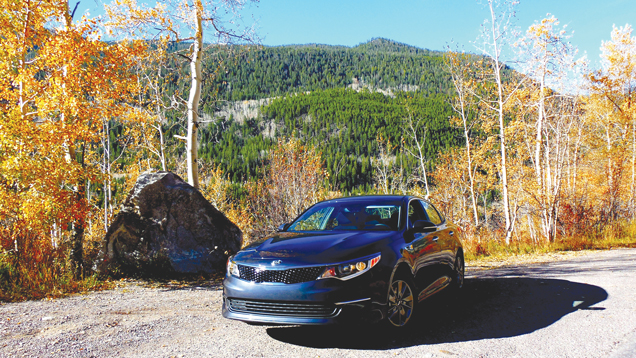The 2016 Kia Optima
 CREDIT: NAUMAN FAROOQ
CREDIT: NAUMAN FAROOQThe previous generation Optima did very well in the market, but it is believed that with the added and improved upon features, the 2016 Optima will do even better.
Some things are deserving of reinvention, while some just need to evolve. The city of Aspen, Colorado first saw settlers back in 1879. The people were drawn to this place due to its amazing topography.
Over time, the city has evolved to include all the amenities needed for living, but at no point did the city lose on what made it great in the first place.
Aspen therefore has something in common with the fourth-generation, 2016 Kia Optima because it isn't an all-new model when compared to the 2015 model, but it builds on the current car's strengths and improves in areas where attention was needed.
Structural rigidity received some attention and thanks to Kia being under the Hyundai umbrella of companies, they have been able to produce a structure that is 50 per cent stiffer than the one on the outgoing model. A stronger structure not only improves ride and handling, but also provides safety for the car's occupants.
The 2016 Kia Optima comes with seven airbags as standard. Apart from the now usual front and side airbags, the new Optima also contains a knee airbag for the driver, which is a brilliant safety feature.
The company has been improving and innovating for quite a long time, and it gets abundantly clear when you approach the 2016 Optima.
It looks familiar because it is similar in appearance to the outgoing model. However, almost all the exterior sheet metal is new. The 2010 to 2015 Optima was and still is a beautiful car, and its aesthetics helped it win over plenty of owners.
But the new model's silhouette is sharper: the nose is now more sculpted, and depending on the model, features different bumpers front and rear. The front bumpers have ditched fog lights and now feature venting to help cool the front brakes — this means faster cooling and less fading.
On the topic of brakes, you get four-wheel disc brakes with anti- lock (ABS), but in addition to that, you get some new or improved features: Hill-start assist, Brake Assist System and auto emergency braking system. All of the aforementioned braking systems are to guarantee the safety of the driver.
In addition to the braking features, the Kia Optima also contains items such as an available reversing camera, with cross traffic alert system, lane departure warning, a blind spot detection system and active cruise control. All of these features are available on a mid-size sedan expected to cost less than $40,000.
The drivetrain for the 2016 Optima is top notch. You get a choice of three engines: the carry over motors are the 2.4 litres, four cylinder engine, that now develops 185 horsepower and 178 pound per foot of torque. The 2.0 litre, four cylinder engine, turbocharged motor, that now develops 245 horsepower and 260 pound per foot of torque.
These two motors send power to the front wheels via a six-speed automatic transmission that is silky smooth in operation.
However, the big news on the drivetrain front is the new 1.6 litre, four cylinder turbocharged motor that develops 178 horsepower and 195 pound per foot of torque.
This motor is based on the unit found in the Hyundai Veloster Turbo Coupe, but in the new Optima, it is tuned to trade in a bit of horsepower for torque.
This will be the mid-range motor for Optima buyers, and after spending roughly 200 kilometres behind the wheel of one such model, I came away quite impressed. The motor is smooth and at highway speeds is quite responsive. It isn't perfect though, at slow speeds it takes time to build up boost and its unique seven-speed, dual-clutch transmission can sometimes be left confused as to what gear it should give you when you are exiting a tight corner.
For most people, this drivetrain will do the job just fine. But for those who want more, the old 2.0 litre turbo is the one to go for. It has been re-tweaked, so now it offers most of its available torque at 1,350 revolutions per minute (rpm), and not 1,500 rpm as with the previous model. Therefore, when the motor is set in Sport mode, this car leaps off the line like a sprinter.
The car now has a 30-millimetre wider track and a 10-millimetre longer wheelbase.
I always found the Optima to be a good riding vehicle that offered good body composure in the corners and highway speeds, but now it's even better. It's power steering unit might be electronic based, rather than the enthusiasts preferred hydraulic based, but Kia's engineers have dialed in the right amount of feedback, so you're not guessing as to what the front wheels are doing. The steering has a good on-center feel, something that was a lacking with the old model.
The 2016 Kia Optima then has grown up, but still has the same exterior dimensions as the old model.
I could find nothing about this car that bothered me; in fact, I liked this car so much, I cannot wait to spend more time with it, a full-week test is due.
As mentioned earlier, exact pricing is not out yet, but between $23,500 and $38,000 is the rough number the press was told at the launch.
No one needs to redesign the wheel, but it can improved upon with clever evolution, and that is what Kia did with this new Optima. It might not be all new, but it is most definitely better than before.














